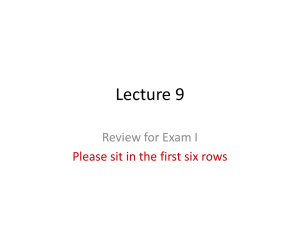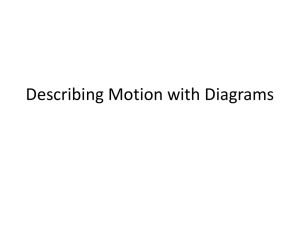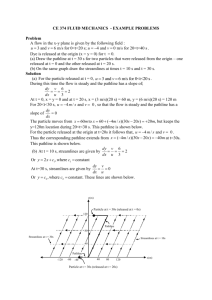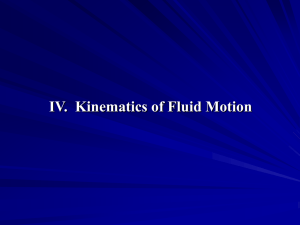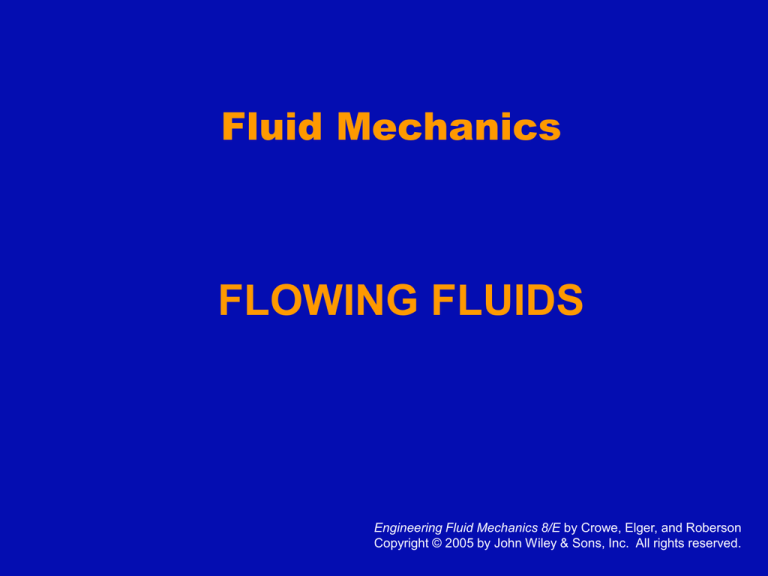
Fluid Mechanics
FLOWING FLUIDS
Engineering Fluid Mechanics 8/E by Crowe, Elger, and Roberson
Copyright © 2005 by John Wiley & Sons, Inc. All rights reserved.
Streamlines & Flow Patterns
Flow Pattern: Construction of streamlines showing the flow direction
Streamlines (light blue): Local velocity vector is tangent to the streamline
at every point along the line at a single instant.
Flow through an opening in a tank &
over an airfoil section.
Streamline & Pathline
Streamline: line drawn through flow field such that local
velocity vector is tangent at every point at that instant
– Tells direction of velocity vector
– Does not directly indicate magnitude of velocity
• Pathline: shows the movement of a particle over time
► In unsteady flow, all can be distinct lines.
► The latter two tells us the history of flow as the former
indicates the current flow pattern.
Examples...
Predicted streamline pattern over the
Volvo ECC prototype.
Pathlines of floating particles.
TYPES OF FLOW
Express velocity V = V(s,t)
Uniform: Velocity is constant along a streamline
(Streamlines are straight and parallel)
V
0
s
Non-uniform: Velocity changes along
a streamline (Streamlines are curved
and/or not parallel)
V
0
s
Vortex flow
TYPES OF FLOW
Steady: streamline patterns are not changing over time
V
0
t
Unsteady: velocity at a point on a streamline changes over
time
V
0
t
Flow patterns can tell you whether flow is uniform or
non-uniform, but not steady vs. unsteady… Why?
Because streamlines are only instantaneous representation of the
flow velocity.
LAMINAR & TURBULENT FLOW
(a)
(b)
(a) Experiment to illustrate the type of the flow
(b) Typical dye streaks for different cases
LAMINAR & TURBULENT FLOW
Engineering Fluid Mechanics 8/E by Crowe, Elger, and Roberson
Copyright © 2005 by John Wiley & Sons, Inc. All rights reserved.
DIMENSIONALITY OF FLOW FLIED
→ Characterized by the number of spatial dimensions needed to describe velocity field.
1-D flow:
Axisymmetric uniform flow
in a circular duct
2-D flow:
Uniform flow in a square
duct
3-D flow:
Uniform flow in an
expanding square duct
FLOW ACCELERATION (rate of change of velocity with time)
• Consider a fluid particle moving along
a pathline...
• There are two components of
acceleration:
Tangential to pathline
at : the time-dependent acceleration
related to change in speed.
Normal to pathline
an : the centripetal acceleration
related to motion along a curved
pathline.
Flow Acceleration
Local acceleration – occurs when flow is unsteady (direction
or magnitude is changing with respect to time)
Convective acceleration – occurs when flow is nonuniform
(acceleration can depend on position in a flow field)
Centripetal acceleration – occurs when the pathline is curved
(normal to the pathline & directed toward the center of rotation)
Example: Convective Acceleration
The nozzle shown below is 0.5 meters long. Find the convective
acceleration at x = 0.25 m. The equation describing velocity
variation is provided below.
Problem 4.17:
Problem 4.17: (Solution)
Example:









